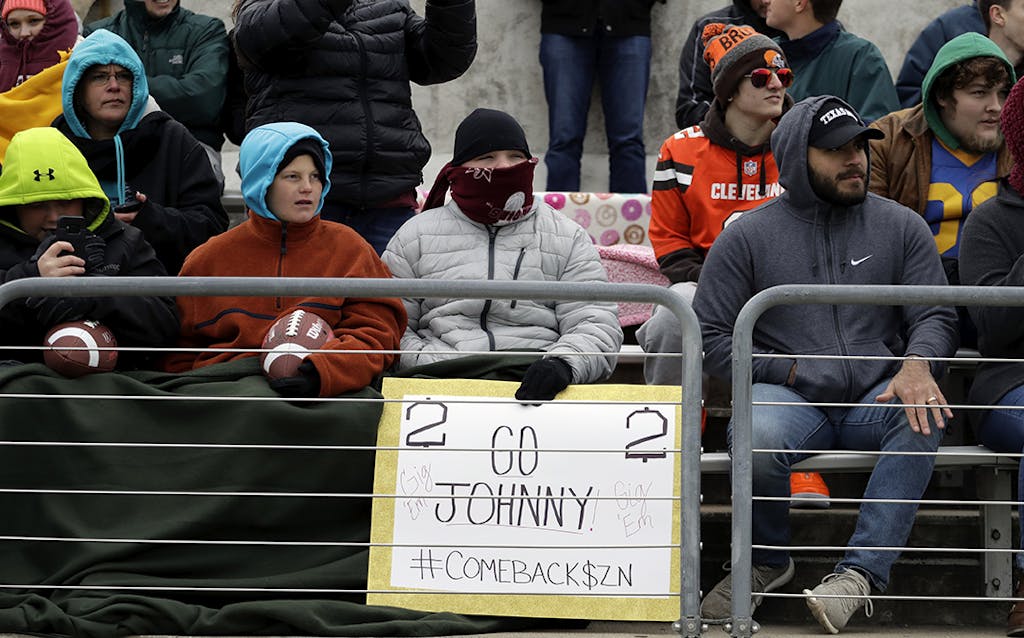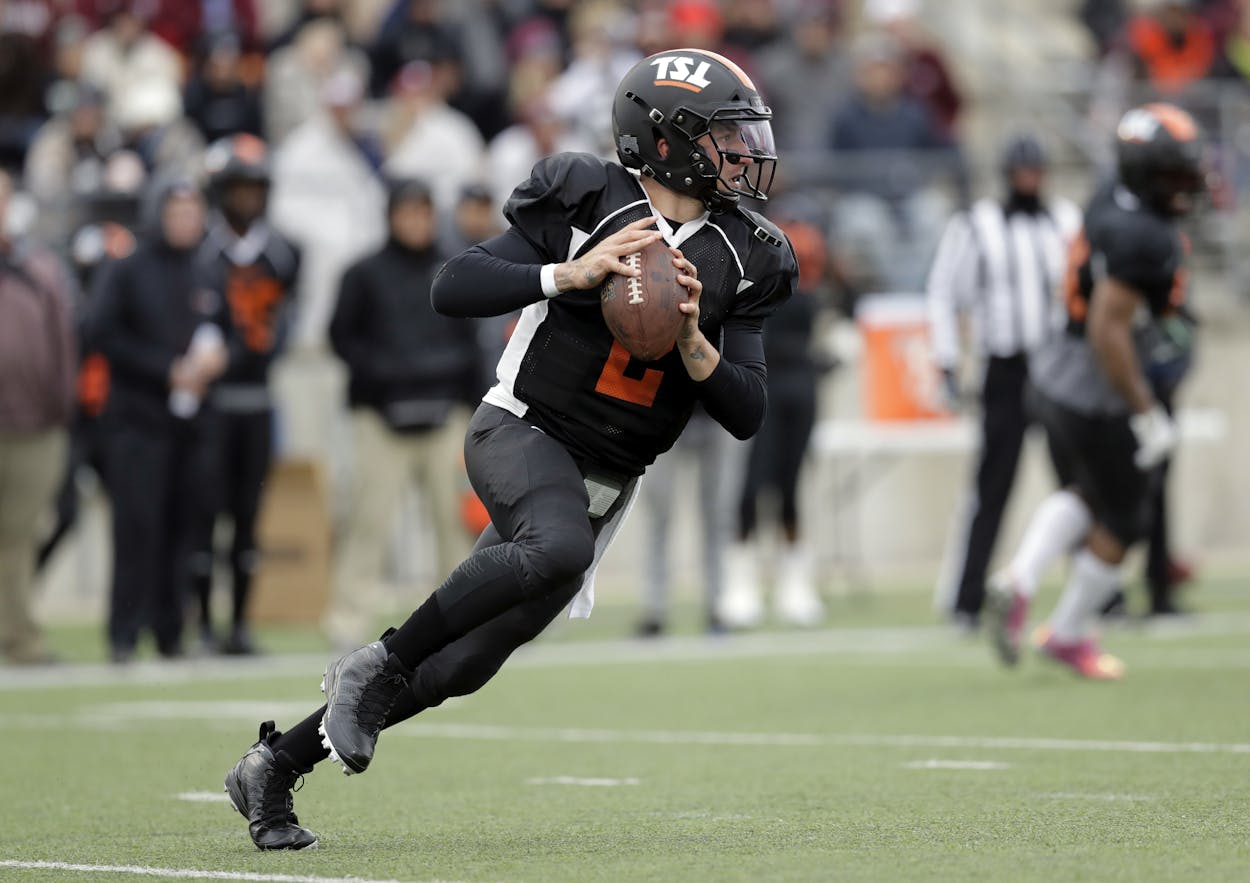Five-and-a-half years ago, red-shirt freshman quarterback Johnny Manziel led his Texas A&M Aggies past the fearsome, undefeated Alabama Crimson Tide in a shocking upset victory that secured him the Heisman Trophy and catapulted him to national celebrity. Four years ago, Manziel, having completed his wildly successful, extremely high-profile, and controversy-plagued college football career, was selected by the Cleveland Browns with the 22nd overall pick in the NFL draft and vowed to his new quarterbacks coach that they would “wreck this league together.” A little over two years ago, Manziel found himself out of a job following a couple of lackluster seasons in Cleveland during which he seemed determined mostly to wreck himself through a self-destructive run that included substance abuse, wild partying, and an allegation of domestic assault against his girlfriend for which he was later charged. (In February 2016, a week after the alleged assault, Manziel’s father told the Dallas Morning News, “I truly believe if they can’t get him help, he won’t live to see his 24th birthday.”) And earlier this week, on April 10, 2018, I watched as Manziel—now 25, married, and, he says, sober—jogged onto the field at Kelly Reeves Stadium in north Austin for his last full-contact practice at the Spring League, a two-week showcase for NFL hopefuls.
Manziel came to Austin on March 28 for the latest stop on a redemption tour he has branded his #ComebackSZN, and his two weeks here went well. Manziel stayed out of trouble and earned the respect of his fellow Spring League players. (“When I make a good throw he’s one of the first ones there to high-five me or compliment me,” one of Manziel’s fellow quarterbacks told me. “Johnny hasn’t big-timed me.”) He got good press, with reports that he was now a “completely different person” off the field and might just be “head and shoulders above the rest” on it. In his first game, on April 7, he had looked at times like the Heisman-winning Johnny Football, at one point scrambling away from pass rushers and firing a strike downfield for a touchdown. In his second and final game, on April 12, he improved on his performance, putting together an impressive first half in which he completed eighty percent of his passes and rushed for two scores. On the day, I saw him practice, Manziel was sharp. He flung tight spirals around the field. He guided the ball through tiny openings in the coverage, hitting his receivers in stride. At one point, he lofted a perfect parabola that managed to narrowly skirt a defense back, plunging impressively into the outstretched hands of his wideout just a few feet from the back of the end zone.
But as Manziel put on this clinic of quarterback accuracy and panache, almost no one was watching. Nearly all the NFL scouts who had come to earlier practices had either seen enough of the Spring League or were waiting to return for the final games. A few Canadian Football League representatives hung around the edges of the field, but Manziel wasn’t their focus. (The Hamilton Tiger-Cats already control his Canadian rights.) And Manziel’s two comeback games had shown that he perhaps wasn’t so different from the other Spring Leaguers around him, a collection of some 150 former college players and ex-pros. In Manziel’s first game, his final passing statistics were a mediocre nine completions in fifteen attempts for 83 yards, and he’d failed to lead his team to victory when he got the ball with two minutes left, down by four points. In his second, he followed up a dominant first half with a second half appearance in which he completed only two of eight passes and threw an interception. After that final game, Manziel told ESPN that simply playing again was a huge step. “It’s been beyond my wildest dreams” he said. “There was a time there I didn’t know if I would actually do it.”

The Spring League launched in 2017 (its first season took place at the Greenbriar Resort in White Sulphur Springs, West Virginia), and if you’re someone who dreams about playing professional football, it’s about the last place you want to end up. Players in the Spring League don’t get paid. In fact, they pay a fee to the league. They have to provide their own insurance. They get room and board as part of their package, but their accommodations are decidedly unglamorous. (This year, players stayed at the Crowne Plaza Austin, which sits under the towering interchange between Interstate 35 and U.S. 290 East.) Players do get instruction from former NFL coordinators and positions coaches, but for most of them, the experience will amount to little more than a fantasy camp. Only a handful of players will be signed to any kind of professional contract after the league, and not one of them is likely to start an NFL game during this upcoming season. As Brian Woods, the league’s CEO, told me, “to be quite honest, the guys here are fringe prospects.”
That doesn’t mean that the players who came to Austin lacked talent—there were 27 former NFL draft picks in the group. But injuries, age, competition, and missed opportunities had pushed each one of them close to the end of the line. And on the day I visited Kelly Reeves Stadium, I talked with several of the league’s participants about just what that meant for them. They were guys around Manziel’s age, a few years out of college and wrestling with the kind of question that’s familiar to most 24- and 25-year-olds: What am I going to do with the rest of my life?
In the stadium parking lot, I met Quinn Epperly, a quarterback who had been the Ivy League Offensive Player of the Year in 2013 after leading Princeton to a championship. He told me that he was now spending his time flipping houses with his wife in his hometown of Knoxville, Tennessee, while also training quietly in the hopes the NFL would give him a serious look.
On the sidelines, I talked with Dylan Haines, a former starting safety at UT, who was still hoping for a free-agent deal but had gotten a real-estate license to pay the bills in the mean time. “I just need someone to give me an opportunity,” Haines told me. “I think at the end of the day, everyone out here knows they can play in the NFL, but if you’re not getting any interest from teams, as time goes by you’re forgotten about—they get new draft classes every year.”
Beneath the stands, I sat down with Adrian Sterling, a running back from Pennsylvania who told me about his double life supervising before- and after-school programs for elementary and middle-school kids, while also training during his off-hours at a Parisi Speed School in Fairlawn, New Jersey. “I don’t let anyone know that I’m pursuing it,” Sterling said. “Anytime you’re chasing a dream, people always want to add their two cents, so I keep football really private.”
Manziel doesn’t have this luxury, and he probably wouldn’t want it if he did. He hasn’t played a down in the NFL since 2015, but he remains among the most famous football players in America, and, after all, even his attempted comeback has come with a copyrighted logo and an apparel store in which you could buy “Money Manziel $2” t-shirts. (All of the products are now sold out.) So far in 2018, Manziel has participated in two pro-day workouts and given a series of confessional interviews, in which he has revealed that he has been diagnosed with bipolar disorder, spoken earnestly of the “meaningless and pointless and selfish” things he has done, and promised that he has “cut out a lot of the leeches in my life.” The NFL can’t quite resist him either. He has started a grand total of eight pro games, but the league’s official website has still dutifully tracked every development in his #ComebackSZN, with highlight videos, interviews, and articles speculating on the quarterback’s potential landing spots.
But it remains unclear if any actual NFL team will want Manziel. Would a league that has exiled the far-more accomplished Colin Kaepernick after his civil-rights activism really want to take a flier on Manziel and all the baggage he would bring? Manziel has sounded earnest and contrite over the last few months, and he’s certainly gotten far more media-savvy. (Addressing the awkward possibility that he would be signed while Kaepernick stayed unemployed, Manziel wrote on Twitter that his fellow quarterback should be playing and that “his impact off the field from a societal standpoint is legendary and straight admirable.”) But, if you believe the celebrity-gossip website The Blast, Dancing With the Stars turned down Manziel’s bid to be on the show this year because he was “too controversial.” Unless Manziel starts looking like Tom Brady in his prime, why wouldn’t all 32 NFL teams come to the same conclusion too?
Manziel arrived in Austin only after exhausting his options. In 2017, Woods had invited the quarterback to join the Spring League for its then-upcoming inaugural season. The offer came with conditions: Manziel first had to pass a drug test and agree to nightly 9:30 p.m. check-ins. (The details leaked to TMZ.) Manziel declined the offer then, but a year later, in February 2018, the quarterback, who has a standing offer to play in Canada, decided to give the Spring League a try.
“He’d been out of the NFL another full calendar year, and the pressure was on for him to be active and remain relevant,” Woods explained. “The Spring League just seemed like a very good fit for both parties.” (This year’s offer, Woods said, came without special conditions.)
For Manziel, the league has been the early culmination of his #ComebackSZN and a place where he can focus on football and be protected. When I asked if I could interview Manziel, Woods told me, “Johnny is talked out, we’re saving him for national outlets.” When I approached a Hamilton Tiger-Cats scout at the same practice, he shut down my questions as soon as I mentioned Manziel’s name. “We have an embargo on everything related to Johnny,” he said.
For the Spring League, Manziel has meant a new kind level of exposure. In its first year, the league was a curiosity, a rag-tag collection of has-beens and never-wases working out in the hills of West Virginia. This year, Manziel has done what he does best: made the league go viral. In his first Spring League game, Manziel drew so many viewers online that it brought down Bleacher Report Live’s streaming site.
“We had such a great audience tuning in for that game, which as you know included Johnny Manziel, that the server slowed and eventually crashed,” Woods told me. “We had 128,000 people just watching on iPhones alone before that happened. I think our media partner might have underestimated the number of interested parties that wanted to see Johnny back on the field.”
But getting eyeballs has never been Manziel’s problem. Acting responsibly off the field has been. So far in 2018, Manziel has been desperate to show that he’s a changed man. If he is, then his next challenge is the same that’s facing Quinn Epperly, Dylan Haines, Adrian Sterling, and every other Spring League player: to convince some NFL team—any NFL team—that the man once known as Johnny Football deserves another shot.
This piece has been modified since publication.
- More About:
- Sports
- Football
- Johnny Manziel







